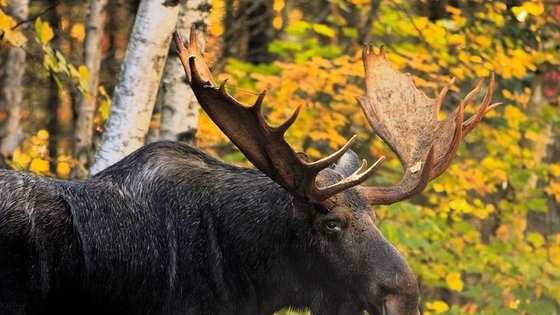Most moose calves in study died this winter
Winter tick blamed on 74 percent mortality

The news is not good for moose calves who are part of a five-year mortality study.
Winter tick claimed 74 percent of the moose calves collared in the study.
That compares to a 64 percent mortality among moose calves from the previous year.
Kristine Rines, the state's moose project leader, said she was not surprised by the grim statistics.
The good news is that most of the adults in the study survived. Only one female adult and one yearling died with GPS collars. The vast majority were moose calves.
The moose are now calving and about 40 percent of those in this study have been seen with one calf.
"We won't know for a number of weeks what's transpired," she said, but she is hoping that snow, which lingered in the woods perhaps longer than last year, might help to reduce the number of winter ticks.
Lee Kantar of Maine's Department of Inland Fisheries and Wildlife in Bangor, and Rines are collaborating in their study of what is happening in their respective states.
Maine is vast and further north than New Hampshire. It has higher densities of moose. Maine has roughly 60,000 moose compared to New Hampshire's 4,000.
The study area straddles the two states near Errol.
The past winter has been hard on all animals, she said, because it takes more energy to stay warm. The snow makes it difficult to move in search of food.
New Hampshire had a high of about 7,000 moose in 1998 and 1999, but Rines said pressure to reduce the density because of traffic deaths accounted for about half the decline.
The state is now below goal for moose capacity in most regions.
A limited lottery to hunt moose is still on, but only 104 tags will be issued. This compares to a high of about 650 a decade ago.
In Maine, a proposal is to reduce the hunt slightly to a lottery with 2,815 tags, down from 3,095 in 2014, Kantar said in March.
Rines said she and Kantar are looking at the possibility of a moving habitat line due to weather change.
If the ticks fall on to snow, they die. But if they fall on to the cold ground, they can survive and reproduce.
Kantar said while one year might lead to a small adjustment, it is the cumulative effect or frequency of year after year of such problems and what that means over time to the moose population.
He said New Hampshire is "a star in terms of research on moose so we are pretty excited to do a comparative study together."
This will be the second spring of the five-year study. The two states are using the same contractor to wrangle and collar the moose from helicopters.
If the animal stops all movement for four hours, a signal goes off and the animal can be recovered for study.
Moose are abundant in Scandinavia and places like Canada's Newfoundland, but declines are being noted in more southern edges of their range in places like Minnesota, Washington and Wyoming.

